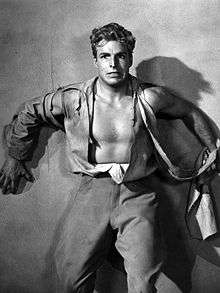Science Fiction/Double Feature
| "Science Fiction/Double Feature" | |
|---|---|
| Song by Richard O'Brien from the album The Rocky Horror Picture Show: Music From The Motion Picture | |
| Released | 1975 |
| Recorded | London |
| Genre | Soft rock |
| Label | Ode Records |
| Writer(s) | Richard O'Brien |
| Composer(s) | Richard O'Brien/Richard Hartley |
| Language | English |
| Producer(s) | Lou Adler |
| The Rocky Horror Picture Show: Music From The Motion Picture track listing | |
| |
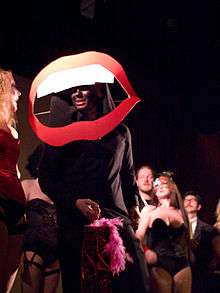
"Science Fiction/Double Feature" is the opening song to the original 1973 musical stage production, The Rocky Horror Show as well as its 1975 film counterpart The Rocky Horror Picture Show, book, music and lyrics by Richard O'Brien, musical arrangements by Richard Hartley. The song is reprised at the end of the show, with lyrics that reflect on the final events of the story.
The song is a tribute to and sendup of various B movies and serials parodied in the show itself.[1]
Overview
The film opens with a title sequence of a disembodied mouth[2] (inspired by the surreal Man Ray painting A l'heure de l'observatoire, les Amoureux (Observatory Time, the Lovers)) against a black background singing in homage to classic science fiction films.[3] It was sung by Richard O'Brien and lip synced, as the now-iconic pair of red lips, by co-star Patricia Quinn.[4] In its original incarnation, The Rocky Horror Show, the song was performed by the character Magenta doubling as the credited role of "Usherette". This character took on the unofficial names of "Miss Strawberry Time", "Trixie" and the "Belasco Popcorn Girl" from props carried on stage during the number. For the filming of the opening sequence, Quinn's head had to be strapped to a board to keep it stationary for filming.
The song is made up of fragments from 1950s subgenre horror and science fiction films and likened to that of avant-garde artist Tristan Tzara by author Vera Dika in her book, Recycled Culture in Contemporary Art and Film. Tzara would construct poems by taking snippets of words from newspapers and placing them into a bag to randomly draw from and arrange. Instead, the words in "Science Fiction/Double Feature" are purposely made to rhyme with a set structure and set with phrases that create cohesion.[5]
The original concept of the song for the feature film as indicated in the original script was to have film clips of each movie shown with a scratched aged effect overlay during the song and opening credits. The idea was dropped when it became apparent that the cost of acquiring the rights to these clips in 1974 was far too prohibitive.
The song is in the key of A major and the reprise of the song is in the key of B♭ major.
Musical number
In the original stage version, the prologue of the show features the usherette singing "Science Fiction/Double Feature" as she enters after the theater lighting has been dimmed. A spotlight follows her as she carries her refreshment tray down the aisle and onto the stage.
In the film version, production designer Brian Thomson decided to use Patricia Quinn's lipsticked mouth against a black background, lip syncing to Richard O'Brien's vocal, with the picture inverted. Inspired by the Man Ray painting entitled Lips (1966), the opening number (prologue) is sung by these disembodied lips that freeze in place for the credits. The prologue was originally going to feature shots from the films referenced in the song under the opening credits.
Films referenced in the lyrics
The Day the Earth Stood Still
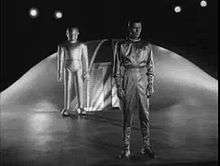
20th Century Fox (1951)
"Michael Rennie was ill the day the earth stood still, but he told us where we stand"
The story of a humanoid alien visitor who comes to Earth with a warning. The film stars Michael Rennie, Patricia Neal, Sam Jaffe, and Hugh Marlowe, under the direction of Robert Wise. Screenwriter Edmund H. North based the screenplay on the 1940 Harry Bates' short story "Farewell to the Master." The score was composed by Bernard Herrmann and used two theremin electronic instruments. The film is often considered by movie historians to be one of the classics of the science-fiction genre. Since the release of the movie, the phrase Klaatu barada nikto has appeared repeatedly in fiction and in popular culture. No translation of the phrase was stated in the film.
Rocky Horror uses the theme of a young couple going to a wise, older learned teacher as the catalyst for the plot of both the original stage play and film versions.
Flash Gordon
Universal Pictures (1936)
"And Flash Gordon was there in silver underwear"
Serial film which tells the story of three people from Earth who travel to the planet Mongo to fight the evil Emperor Ming the Merciless. Buster Crabbe, Jean Rogers, Charles B. Middleton, Priscilla Lawson and Frank Shannon played the central roles. This serial has been selected for preservation in the United States National Film Registry.
The entire film was produced to be shown in small episodes shown with deliberate cliffhangers to bring the audience back.
The film was remade in 1980 directed by Mike Hodges and produced by Dino De Laurentiis. It stars Sam J. Jones, Melody Anderson, Chaim Topol, Max von Sydow, Timothy Dalton, Brian Blessed and Ornella Muti. The screenplay was written by Michael Allin (of Enter the Dragon fame) and Lorenzo Semple, Jr. It intentionally uses a camp style similar to the 1960s TV series Batman (for which Semple had written many episodes) in an attempt to appeal to fans of the original comics and serial films. The film is notable for its soundtrack composed by rock band Queen. In an ironic move, Richard O'Brien, creator of Rocky Horror and songwriter of "Science Fiction/Double Feature" was cast in a small part.
The Invisible Man

Universal Pictures (1933)
"Claude Rains was The Invisible Man"
A 1933 horror film based on H. G. Wells' science fiction novel The Invisible Man, published in 1897, as adapted by R. C. Sherriff, Philip Wylie and Preston Sturges, whose work was considered unsatisfactory and who was taken off the project. The film was directed by James Whale and stars Claude Rains, in his first American screen appearance, and Gloria Stuart. It is considered one of the great Universal Horror films of the 1930s, and spawned a number of sequels, plus many spinoffs using the idea of an "invisible man" that were largely unrelated to Wells' original story.
In his first American screen appearance, Rains portrayed the Invisible Man (Dr. Jack Griffin) mostly only as a disembodied voice. Rains is only shown clearly for a brief time at the end of the film, spending most of his on-screen time covered by bandages.
In 2008, The Invisible Man was selected for preservation in the United States National Film Registry by the Library of Congress as being "culturally, historically, or aesthetically significant".
A nod to this film is directly evident in the fully bandaged figure of Rocky Horror during and after being brought to life.
King Kong
RKO Pictures (1933)
"Then something went wrong for Fay Wray and King Kong, they got caught in a celluloid jam"
A 1933 landmark black-and-white monster film about a gigantic gorilla named "Kong" and how he is captured from a remote lost prehistoric island and brought to civilization against his will. The film was made by RKO and was originally written for the screen by Ruth Rose and James Ashmore Creelman, based on a concept by Merian C. Cooper. A major on-screen credit for Edgar Wallace, sharing the story with Cooper, was unearned, as Wallace became ill soon after his arrival in Hollywood and died without writing a word, but Cooper had promised him credit.[6] A novelization of the screenplay actually appeared in 1932, a year before the film, adapted by Delos W. Lovelace, and contains descriptions of scenes not present in the movie.
The film was directed by Merian C. Cooper and Ernest B. Schoedsack, starred Fay Wray, Robert Armstrong and Bruce Cabot, and is notable for Willis O'Brien's ground-breaking stop-motion animation, Max Steiner's musical score and Fay Wray's performance as the ape's love interest. King Kong premiered in New York City on March 2, 1933 at Radio City Music Hall.
The idea of a gorilla kidnapping and lusting for a human woman is an old concept as reflected in Emmanuel Frémiet's 1887 sculpture Gorilla Carrying off a Woman.
King Kong was influenced by the "Lost World" literary genre, particularly Arthur Conan Doyle's The Lost World (1912) and Edgar Rice Burroughs' The Land That Time Forgot (1918), which depicted remote and isolated jungles teeming with prehistoric life. Furthermore, a film adaptation of the Doyle novel made movie history in 1925, with special effects by Willis O'Brien and the Kong crew.
In one of the more blatant attempts to inject iconic cult imagery, Director Jim Sharman has the creature, Rocky Horror, lift the lifeless body of Frank and carry him up the tower of the RKO logo.
It Came from Outer Space
_title.jpg)
Universal International Pictures (1953)
"Then at a deadly pace it came from outer space"
A 1953 science fiction 3-D film directed by Jack Arnold, and starring Richard Carlson, Barbara Rush, and Charles Drake.
Author and amateur astronomer John Putnam (Carlson) and schoolteacher Ellen Fields (Rush) watch a great meteor crash to earth near the small town of Sand Rock, Arizona. After visiting the crash site, John Putnam notices a strange object at the impact site, and comes to believe the meteor is not a meteor at all, but an alien spaceship. After a landslide covers the mysterious craft, John Putnam's story is ridiculed by the townspeople, the sheriff (Drake), and the local media. Even Ellen is unsure of what to believe at first, but soon agrees to assist John in further investigation. In the following days, several local people disappear. A few return, only to display odd robot-like behavior, and seem distant and removed from their normal selves. Eventually Sheriff Drake also becomes convinced that something more than a meteor is involved, and organizes a posse to root out and destroy the invaders. All alone, John hopes to reach a peaceful solution, entering a mine which he hopes will lead him to the buried spacecraft and its mysterious occupants.
The screenplay was by Harry Essex, with input by Jack Arnold, and was derived from an original screen treatment by Ray Bradbury. Unusual among sci-fi films of the day, the alien "invaders" were portrayed as creatures without malicious intent. The film has been interpreted as a metaphorical refutation of supposedly xenophobic attitudes and ideology of the Cold War.
"I wanted to treat the invaders as beings who were not dangerous, and that was very unusual", Bradbury said. He offered two outlines to the studio, one with malicious aliens, the other with benign aliens. "The studio picked the right concept, and I stayed on."
As author of the original book for the stage production of The Rocky Horror Picture Show, O'Brien uses the alien possession device in a tongue in cheek manner by having the Character of Frank-N-Furter "transform" his captured victims into stone and then force them to perform, removed from their normal selves at the finale.
Doctor X
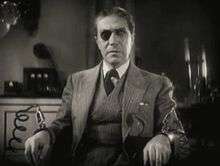
First National Pictures (1932)
"Doctor X will build a creature"
A First National/Warner Bros. horror and mystery film from 1932. Doctor X is a mystery-horror film with tongue-in-cheek comedic elements. In the film, there have been a series of pathological murders that have taken place over a series of months in New York City. The murders always take place at night, under the light of a full moon. Furthermore, each body has been cannibalized after the murder has taken place. Witnesses to the events describe a horribly disfigured "monster" as the killer. The police, a reporter, and the scientist named in the title investigate the murders throughout the film.[7]
It was directed by Michael Curtiz and stars Lee Tracy, Fay Wray, and Lionel Atwill. The film is notable for having been shot in Technicolor and being produced before the motion picture Production Code was enforced. Thus, mature themes such as murder, rape, cannibalism, and prostitution are interwoven into the story.
Forbidden Planet
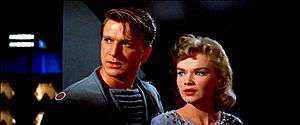
Metro-Goldwyn-Mayer (1956)
"Anne Francis stars in Forbidden Planet"
A 1956 science fiction film directed by Fred M. Wilcox and starring Walter Pidgeon, Anne Francis and Leslie Nielsen. The characters and setting were inspired by Shakespeare's The Tempest,[8] and the plots are very similar.
The film features a number of Oscar-nominated special effects, groundbreaking use of an all-electronic music score, and the first screen appearance of both Robby the Robot[9] and the C-57D flying saucer starship.
In the early 23rd century, the United Planets Cruiser C-57D is sent to the planet Altair IV in the Altair star system, sixteen light years from Earth, to find out the fate of a colony expedition sent out some twenty years earlier. At the end of the year-long voyage, Commander John J. Adams contacts Dr. Edward Morbius, who warns him to stay away, but refuses to give a reason.
Upon landing, the crew is met by Robby the Robot, who takes Adams, his first officer, Lieutenant Jerry Farman, and Lieutenant "Doc" Ostrow to Morbius' home. Morbius explains that a year after the expedition's arrival, some unknown force wiped out nearly everyone in his party and vaporized their starship as the last survivors tried to escape. Only he, his wife (who later died), and his infant daughter survived. Morbius fears that the same fate may await the crew of the C-57D.
Tarantula

Universal International Pictures (1955)
"I knew Leo G. Carroll was over a barrel when Tarantula took to the hills"
A 1955 science fiction film directed by Jack Arnold, and starring Leo G. Carroll, John Agar, and Mara Corday. Among other things, the film is notable for the appearance of a 25-year-old Clint Eastwood in an uncredited role as a jet pilot at the end of the film.
The plot concerns a biological researcher, Professor Gerald Deemer, who is trying to prevent the food shortages which will result from the world's expanding population. With the help of atomic science, he invents a special nutrient on which animals can live exclusively, but which causes them to grow to many times their normal size. In his laboratory, he houses several oversized rodents and, inexplicably, a tarantula.
When his researchers try the nutrient, they develop runaway acromegaly and one of them is driven mad, half destroys the lab (freeing the animals) and attacks Deemer and injects him with the solution. As a result, Deemer gradually becomes more and more deformed while the now-gigantic tarantula ravages the countryside. A sympathetic doctor and Deemer's female assistant investigate the mystery of the clean-picked cattle bones and the eight-foot pools of arachnid venom, and the spider is eventually destroyed, after several failed attempts, by a napalm attack launched from a fighter squadron.
The Day of the Triffids
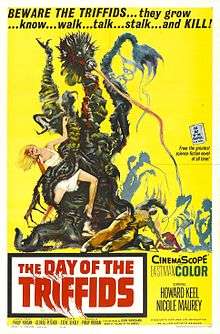
Allied Artists (1962)
"And I really got hot when I saw Janette Scott fight a Triffid that spits poison and kills"
A 1962 British film adaptation of the science fiction novel of the same name by John Wyndham. It was directed by Steve Sekely, and starred Janette Scott and Howard Keel, who played the central character, Bill Masen.[10] The movie was filmed in color with monaural sound and ran for 93 minutes.
Triffids are strange fictional plants, capable of rudimentary animal-like behavior: they are able to uproot themselves and walk, possess a deadly whip-like poisonous sting, and may even have the ability to communicate with each other. On screen they vaguely resemble gigantic asparagus shoots.
Bill Masen begins the story in hospital, with his eyes bandaged. He discovers that while he has been blindfolded, an unusual meteor shower has blinded most people on Earth. Masen finds people in London struggling to stay alive in the face of their new, instantly-acquired affliction, some cooperating, some fighting: after just a few days society is collapsing.
Night of the Demon
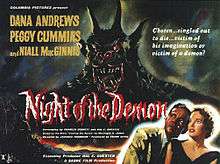
Columbia (1957), released in the United States as Curse of the Demon
"Dana Andrews said prunes gave him the runes, and passing them used lots of skills"
A 1957 British horror film directed by Jacques Tourneur, starring Dana Andrews, Peggy Cummins and Niall MacGinnis. An adaptation of M. R. James' Casting the Runes (1911), the plot revolves around American professor John Holden going to England and investigating a Satanic cult suspected of being responsible for more than one death in recent months.
The film's production was turbulent due to clashing ideas between producer Hal E. Chester against Jacques Tourneur and writer Charles Bennett. Against Bennett and Tourneur's wishes of leaving the supernatural demon's existence up to the audience, Chester demanded to make the demon have a highly visible presence on-camera. The film was also edited further in America in its 1958 debut under the title of The Curse of the Demon, as the second half of a double feature to accompany the film The Revenge of Frankenstein (1958) which, in a twist of deliberate fate contain two very obvious props reused in The Rocky Horror Picture Show, the creation tank and bandaged wrapped dummy.
When Worlds Collide
_trailer_1.jpg)
Paramount Pictures (1951)
"But when worlds collide, said George Pal to his bride, I'm gonna give you some terrible thrills"
A 1951 science fiction film based on the 1932 novel co-written by Philip Gordon Wylie and Edwin Balmer. The movie was filmed in Technicolor, directed by Rudolph Maté and was the winner of the 1951 Academy Award for special effects. George Pal was the producer of When Worlds Collide and the director of the 1953 film War of the Worlds and the 1960 The Time Machine, among other films.
Cover versions
- Cover versions have been recorded by Me First and the Gimme Gimmes, The Black Math Experiment, and Chris Murray.
- The Dresden Dolls have been known to perform it live, both as a band as with vocalist Amanda Palmer solo on the keyboards.
- Dark-Cabaret artist Voltaire has performed this song live.
- Luke Ski parodied the song as "Mystery Science Theater Picture Show", a tribute to Mystery Science Theater 3000.
- In 2004, Joan Jett and the Blackhearts covered this song on the album Naked.
- Jack Antonoff of the band fun. covered the song.
- Naya Rivera (playing the character Santana Lopez) covered the song for The Rocky Horror Glee Show.[11]
- The Forgotten Rebels cover the song on their 1989 album "Untitled."
- The Misfits have occasionally covered the song live as a finale to their encore since 2000, and also releasing a live recording on their 2013 live album Dead Alive!. A studio recording is featured on the B-side of the Descending Angels Single.
- Czech punk'n'roll band Skřehule covered the song on their debut album Internet Amateurs.
- So-Cal Rocket Dynamics, a Los Angeles-based Rockabilly band, covered the song on their 2014 album Too Bad She Won't Live.
- The song is covered occasionally during the Rupaul's Drag Race Battle of the Seasons show. The performance is usually covered by Michelle Visage.
- Ivy Levan performed the song as Trixie the Usherette in the opening to Fox's 2016 televised tribute The Rocky Horror Picture Show: Let's Do the Time Warp Again
In other media
- The song appears as Fauxlivia Dunham's ringtone in the 23rd episode of season 2 of the television series, Fringe called Over There Part 2.
- The song is one of many Rocky Horror Picture Show songs that appear in the 21st episode of Season 2 of the television show, Cold Case, titled Creature Of The Night. The episode also pays homage by doing exactly the same end credits as the movie including the reprise of the song.
References
- ↑ Hoberman, Rosenbaum, J., Jonathan (1991). Midnight movies. Da Capo Press. p. 3. ISBN 978-0-306-80433-5.
- ↑ http://www.artofthetitle.com/title/the-rocky-horror-picture-show/
- ↑ http://www.imdb.com/title/tt0073629/trivia?ref_=ttcc_sa_1
- ↑ Knapp, Raymond (2006). The American musical and the performance of personal identity. Princeton University Press. p. 247. ISBN 978-0-691-12524-4.
- ↑ Dika, Vera (2003). Recycled culture in contemporary art and film. Cambridge University Press. p. 108. ISBN 978-0-521-01631-5.
- ↑ Goldner, Orville; Turner, George E. The Making of King Kong, Ballantine Books, 1975.
- ↑ http://horrorpedia.com/2012/12/01/doctor-x/?. Missing or empty
|title=(help) - ↑ "Forbidden Planet (1956)". Internet Movie Database. Retrieved 2006-08-14.
- ↑ "The Robot Hall of Fame : Robby, the Robot". The Robot Hall of Fame (Carnegie Mellon University). Retrieved 2006-08-14.
- ↑ Hunter, I. Q. (2002). British Science Fiction Cinema. Routledge. pp. 80–81. ISBN 0-203-00977-0.
- ↑ 'Glee' Rocky Horror ep: Who sang the opening song? We have your answer. Entertainment Weekly. Retrieved 27-10-2010.
